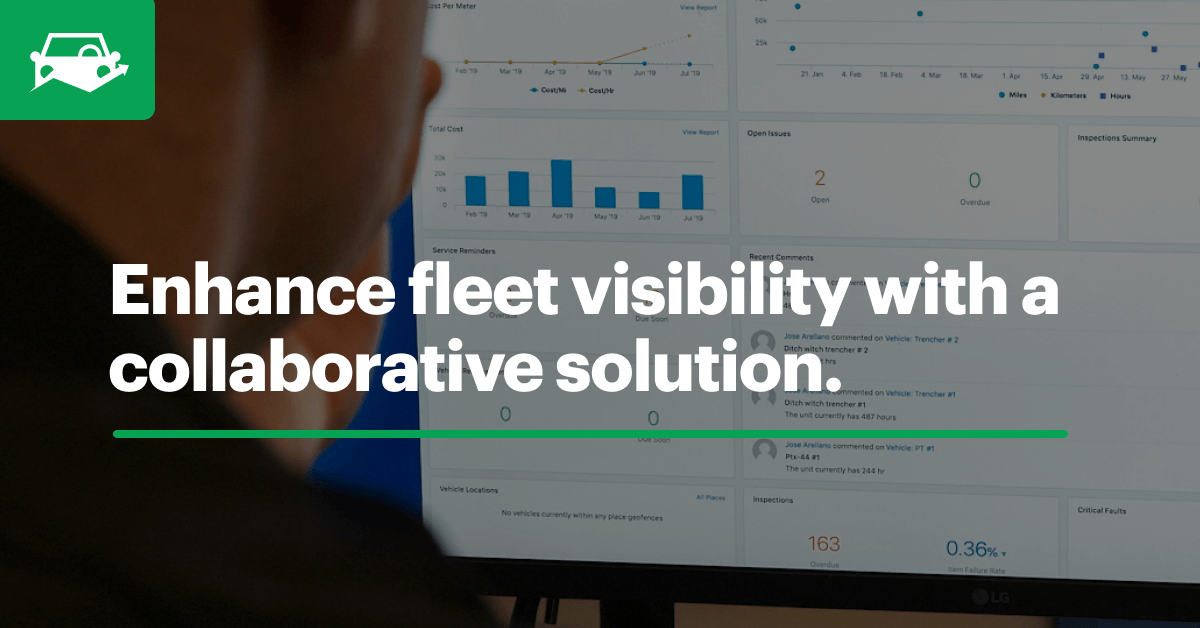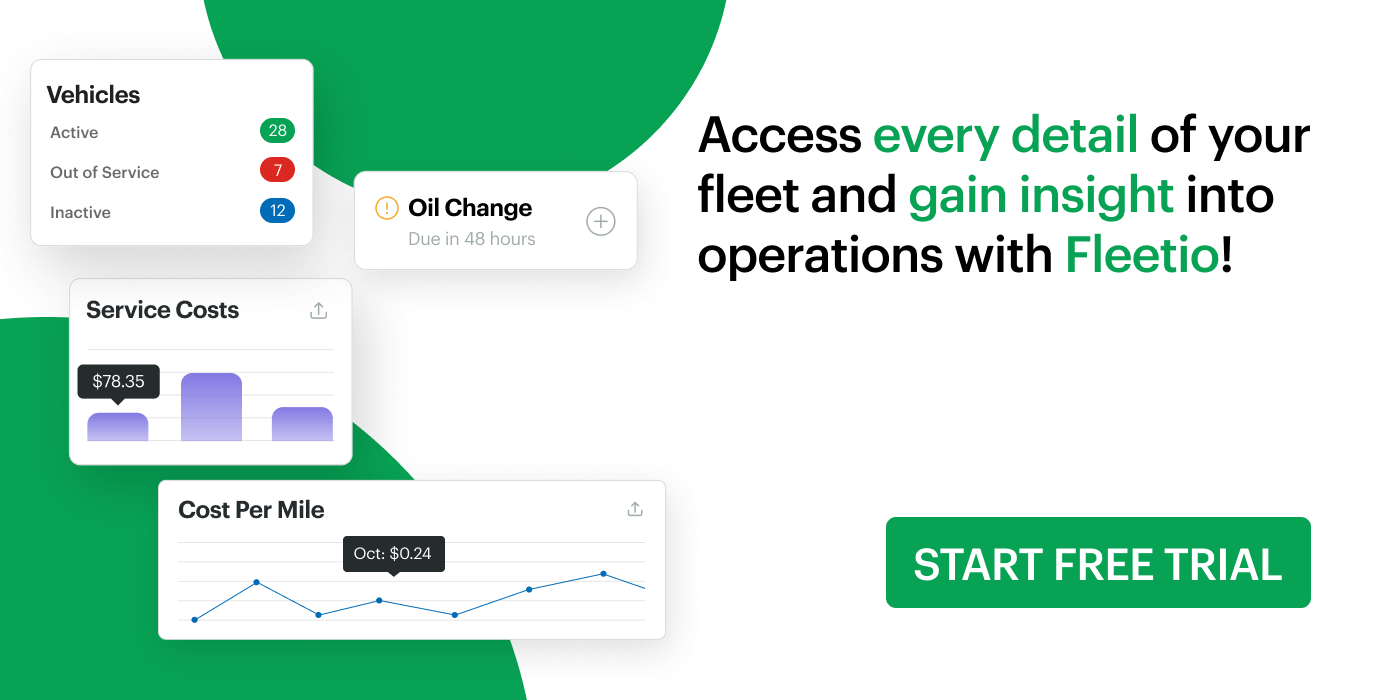Some organizations struggle with maintaining optimal fleet visibility and monitoring asset health and expenses in real time. Leveraging a collaborative fleet management software provides a complete view of fleet insights for you to make data-driven decisions to improve operations.

Gaining Fleet Visibility and Insights
Maintaining fleet visibility is one of the most important aspects of fleet management, yet it can often be a challenge for many fleet managers. Using outdated systems like spreadsheets and paper doesn’t provide real-time insight into how your fleet operates, which can result in inefficiencies, downtime and poor decisions regarding expenses.
Using a collaborative software solution allows you to gain fleet insight by monitoring asset health and expenses and collaborating with your team on maintenance tasks. By managing everything in a comprehensive platform, you can easily view fleet metrics and bridge the gap between the field and office to monitor team productivity.
Asset Utilization and Telematics Tracking
Telematics Integrations
Most fleets leverage some type of onboard GPS or telematics tool, but many aren’t taking full advantage of the fleet data they gather. Knowing where your assets are on the map is certainly important to monitor productivity, but you should also be leveraging telematics data to track and improve other areas of your fleet, including maintenance.
Pairing your GPS or telematics tool with fleet management software provides enhanced fleet visibility by providing real-time access to data including:
- Odometer readings
- Diagnostic Trouble Codes (DTC)
- Fuel Exception Reporting
- Driver Vehicle Inspection Reports (DVIR)
In addition to knowing where your vehicles are, integrating telematics data into fleet management software gives you insight into what’s going on under the hood and can automatically trigger service reminders and other maintenance workflows. Capturing all of your fleet’s data on a single platform ensures you have maximum visibility into how your assets function.
Asset Utilization
Getting the most out of your vehicles is imperative to your bottom line, and understanding whether you under- or over-utilize vehicles can help you make decisions that will help you maximize your fleet’s profitability.
Fleet management software tracks asset utilization through configurable reports, allowing you to closely monitor how and when your vehicles are being used. These reports maximize fleet visibility and allow you to determine the optimal utilization rate for your fleet.
With this level of fleet insight, you can determine a sustainable strategy for vehicle usage that ensures you meet demand by having the right number of vehicles while avoiding the risk of overspending on underutilized vehicles.
Expense Tracking
Fuel and Maintenance
Fuel and maintenance are often the largest ongoing expenses for fleets, so it’s imperative that you closely monitor expenses to stay on budget. Both of these can be easily tracked in fleet management software to gain comprehensive fleet insight.
Whether you manage maintenance in-house or outsource to a third party, fleet management software enables you to track all maintenance expense information. Not only does this keep you informed, but it also eliminates tedious data entry and ensures all expense information is accurate.
Tracking fuel costs and consumption can be frustrating when you’re trying to calculate total spend based on fuel receipts. Having your drivers log fuel in a mobile fleet management app or integrating your fuel cards with fleet management software provides real-time fleet insight like cost per mile and fuel economy. This keeps you informed and allows you to spot discrepancies and determine ways to reduce fuel spend across your fleet.
Fleet Total Cost of Ownership (TCO)
Knowing your total operating costs is one of the most valuable fleet insights, as it ultimately determines your return on investment (ROI) and the success of your business. Calculating TCO can be one of the more challenging tasks of a fleet manager who uses outdated management systems.
Gaining real-time visibility into your fleet’s operating costs doesn’t have to be difficult, though. Fleet management software provides a simple solution to calculating and tracking your TCO. Managing all fleet data on a single platform ensures you have accurate, up-to-date information regarding operating expenses. This level of fleet visibility empowers you to identify spending trends across your fleet and determine strategies to improve your bottom line.
Vehicle Replacement
When it comes to vehicle replacement, comprehensive fleet insight into asset utilization, service history and expense data is necessary to determine the best time for your fleet to replace assets.
Leveraging a robust fleet management software that provides visibility into all of your fleet’s metrics can help you easily determine optimal vehicle replacement schedules. By managing all of your fleet’s data on a single platform, allows you to make connections between maintenance trends and operating costs to make better replacement decisions.
Fleetio’s Optimal Replacement Analysis tool allows you to take a data-driven approach to vehicle replacement. Fleet managers can forecast replacement based on a number of factors including operating expenses and utilization and see how changes in estimates can lengthen asset lifespan.
Maintenance Management
Inspections
Effective fleet maintenance management plans are proactive in nature. Routinely inspecting your vehicles is the best way to monitor fleet health and resolve any vehicle issues before they compound.
Unfortunately, fleet managers who rely on paper inspection forms don’t get instant fleet visibility when they need it. Issues may not be communicated for weeks at a time, resulting in vehicle breakdowns.
With a mobile vehicle inspection app, drivers can instantly upload inspection results to keep managers informed. When an inspection item fails, managers are alerted immediately and can begin to schedule maintenance. Leveraging electronic inspections improves fleet visibility to keep you proactively managing maintenance.
Preventive Maintenance
In addition to leveraging vehicle inspection data to stay proactive, keeping up with recommended preventive maintenance (PM) allows you to avoid downtime, lengthen asset lifespan and regularly monitor asset condition.
While staying up-to-date on preventive maintenance can be challenging for some fleets, leveraging fleet management software to create maintenance schedules and automate service reminders simplifies the process. Creating preventive maintenance schedules for your vehicles (whether individually or in bulk) increases fleet visibility and ensures your vehicles are routinely serviced.
Fleet management software also provides greater fleet visibility into preventive maintenance by forecasting upcoming service needs based on a vehicle’s usage. With this data, you can adjust maintenance schedules to improve your operations.
Work Orders
Using a mobile platform to implement efficient maintenance workflows increases fleet visibility and keeps your team productive. Fleet managers can create, assign and monitor mobile work orders to eliminate chaotic paperwork and track maintenance in an organized system.
With configurable reports, fleet managers can gain insight into different areas of your maintenance plan including:
- Work order completion rate
- Detailed expense totals for parts, labor and service
- Parts and inventory levels
- Complete service history
- Outstanding and resolved issues
- Fault code summaries
Managing all maintenance data on a single platform like fleet management software not only maximizes fleet insight, but it also increases the value of your data. With easy-to-read maintenance reports, you can monitor asset health, identify areas of improvement and keep your fleet productive.
Enhance fleet visibility to improve your operations! Start your free trial of Fleetio or request a demo today.




